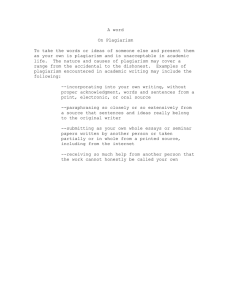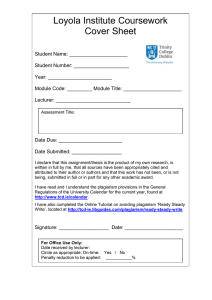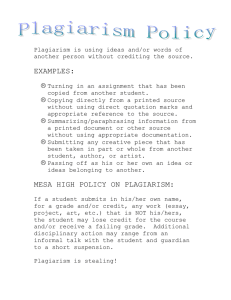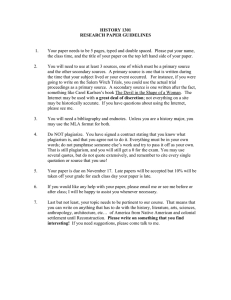School of Physics Plagiarism: what it is and what will
advertisement
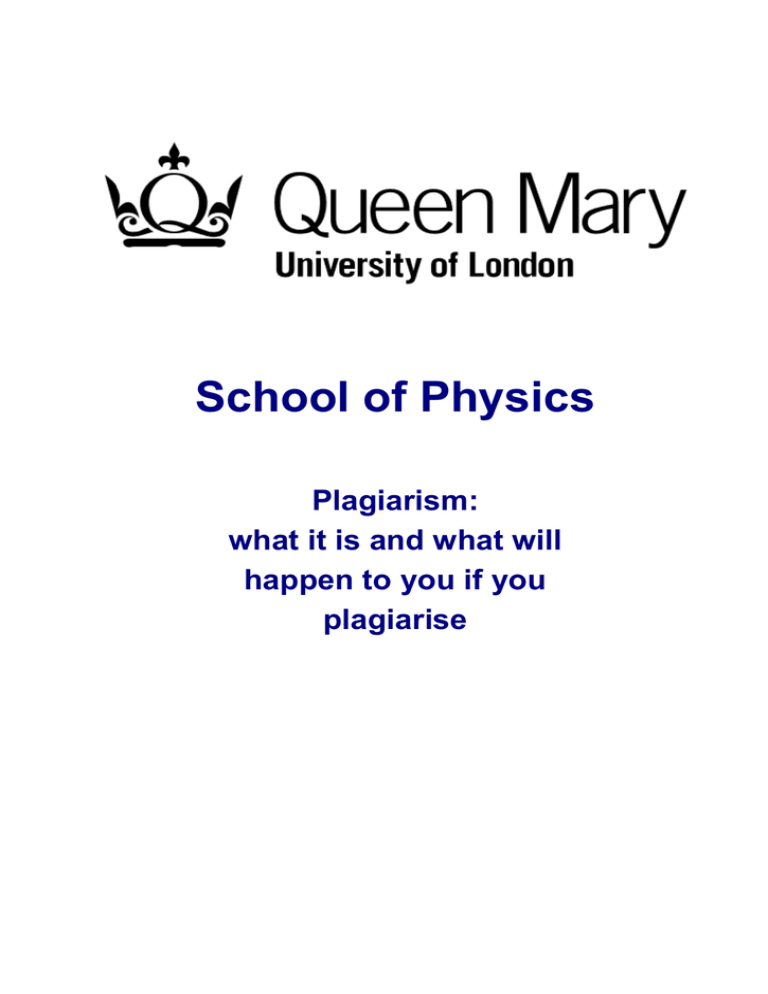
School of Physics Plagiarism: what it is and what will happen to you if you plagiarise Physics School Plagiarism 1. Introduction........................................................................................................................................................... 1 2. Plagiarism ............................................................................................................................................................. 1 3. Acceptable and Unacceptable Practice ................................................................................................................. 1 3.1 Exercise Assignments .................................................................................................................................... 1 3.2 Laboratory Reports......................................................................................................................................... 1 3.3 Computer Programs ....................................................................................................................................... 1 3.4 Essays and Review Projects ........................................................................................................................... 1 3.5 Use of the Web ............................................................................................................................................... 2 4. Penalties for Plagiarism ........................................................................................................................................ 2 4.1 Exercises and Laboratory Work ..................................................................................................................... 2 4.2 Essays and Review Projects ........................................................................................................................... 2 4.3 Appeals Procedure ......................................................................................................................................... 2 4.4 Referral to the College ................................................................................................................................... 2 APPENDIX: STYLES OF REFERENCING............................................................................................................ 3 -i- Version 2.1 (1/9/2004) Physics School Plagiarism 1. INTRODUCTION x2 = 9 There has been a significant increase in attempts by students to pass off the work of other people as their own. This is a very serious offence that may lead to expulsion from College. The purpose of this note is to explain what is and what is not permitted in such detail as to leave no ambiguity in any student’s mind. x = ±3 Such trivial cases are rare, however, in the exercises that you are asked to do. 3.2 Laboratory Reports At the end of the note you will find a form in which you are asked to declare that you have read this document and understand its contents. You are also asked to declare that you understand the consequences of being detected in plagiarising someone else’s work. You will be required to sign this form at the beginning of each of your academic years at Queen Mary. In many cases, you will be working on laboratory experiments in pairs or in larger groups. In such cases, you will probably assign members of the group different roles in setting up the experiment and in taking readings. You will usually also take a joint set of measurements and will discuss their interpretation. All this is good practice. 2. PLAGIARISM When you come to write up your report on the work, however, this must be your own work in your own words. The only extent to which duplication between reports is allowed is if one member of a pair is assigned to adjust the apparatus while the other takes readings. In this case, it is obviously necessary that the one adjusting the equipment should copy the readings taken by the other. No other copying is allowed. To plagiarise is, according to the Concise Oxford Dictionary, to “take and use another person’s (thoughts, writings, inventions, … ) as one’s own”. In everyday words, this means copying or stealing another person’s intellectual property for one’s own use. The theft itself is bad enough but the use of the material, in submitted exercises for example, is an attempt to gain credit by deception. It is this attempt to deceive that calls for severe sanction. It is equally wrong to allow your work to be used by another student for such purpose. 3.3 Computer Programs Computer Programming courses will require you to write your own programs and submit them as coursework, often electronically. Whilst we encourage collaboration and discussion of the algorithms and methods used, the program that you submit must be your own work and must be completely typed into the computer by you. It is easy to compare submitted work electronically and, in all but the most trivial “Hello World” cases, programs that differ only in the names of variables or in the spacing will be treated as suspect and will be investigated. Because we suspect that some students find it difficult to define the boundaries between what is acceptable collaboration or use of material and what is plagiarism, we give some specific detailed examples in the following section. 3. ACCEPTABLE AND UNACCEPTABLE PRACTICE 3.1 Exercise Assignments 3.4 Essays and Review Projects Many courses require students to submit weekly exercises or “homework”. The main purpose of these exercises is to help you understand the course you are studying and it frequently helps greatly with this process to discuss the work with fellow students. Far from objecting to this, we actively encourage as a way of increasing your understanding of the material. Having worked on the problems with other students, however, and perhaps coming to a common understanding of the solution, you must submit your interpretation of that solution in your own words. You must not submit a joint solution using the same words or an identical layout of the answer, nor should you exchange paper or electronic copies of your working. Many of you will have to write an essay as part of your coursework or to undertake a review project. This will involve consulting scientific or other literature, either in hard copy or electronically. Increasingly the web is used to access these sources. Having obtained such material, you may use it in one of three ways. (a) Paraphrasing or Précising: You may summarise the material in your own words, usually condensing it significantly. In this case you must give a reference1 to the source or sources of the material. (b) Attribution: You may say, in your own words, what someone else has said but you must attribute the saying to the original author. In a few cases, of course, the answer can only be given in one way. If you are asked to solve the equation x2 = 9, for example, you can hardly avoid writing (c) Direct Quotation: You may quote directly what someone else has said but you must put the quoted 1 -1- How to refer to cited sources is discussed in the Appendix. Version 2.1 (1/9/2004) Physics School Plagiarism 4.4 Referral to the College words in quotation marks and you must give a reference to the original author. Notwithstanding paragraph 4.3, if the plagiarism concerned constitutes more than 20% of the marks for the course, the School is obliged to refer the matter to the College. A student who directly submits another person's file, with or without modification, will in any case be referred directly to the College. Examples of all three of these are given in the following simple made-up passage. Example Some people working on this problem [e.g., Smith (1994), Jones (1997)] have declared the effect to be real but others [Williams and Cook (2001)] have failed to reproduce the effect. Evans (1999) said that only tests made under micro-gravity conditions would produce definitive results. On the other hand, Johnson (2002) says, “although the effect is not fully understood, it is almost certain that the gravitational field has no effect on the outcome”. The first sentence is an example of (a), the second of (b) and the third of (c). 3.5 Use of the Web The web is a very fruitful source of material. Because the web is so vast, some students have been tempted to think that material plagiarised from obscure – or even not so obscure – sites will not be detected. Be warned that changes in style in an essay are very easy to spot and that search engines are now so powerful that it is very easy to track down the source of suspect material. 4. PENALTIES FOR PLAGIARISM See the URL, www.admin.qmw.ac.uk/registry/Students/discipline.pdf Schedule 1, Sections 3 and 4, for details of the formal College regulations. 4.1 Exercises and Laboratory Work If a student is detected plagiarising another students exercise or laboratory work, he or she will lose the coursework marks for that piece of work, as will the student from whom the work has been taken. 4.2 Essays and Review Projects If a student’s essay or project report is found to contain plagiarised material, the student will lose the coursework marks for that piece of work. Often this corresponds to an automatic fail for that part of the course. 4.3 Appeals Procedure The revoking of marks is the responsibility of the course organiser in the first instance. A student may appeal against such a decision in which case he or she will be required to appear before the School Appeals Panel, comprising the Chairman of the Physics Examination Board, the Senior Tutor, the Chairman of the Teaching Committee and the course organiser concerned. A student not accepting the ruling of this Panel will be summoned before the Head of School and may subsequently be referred to the College. -2- Version 2.1 (1/9/2004) Physics School Plagiarism t APPENDIX: STYLES OF REFERENCING Proper citing of source material is essential. This may be done in one or other of the following two styles. In each case, the first example applies to a paper in a journal, the second to a paper in the proceedings of a conference and the third to a book. FIRST STYLE In the body of the Essay or Report: “It can be shown [5] that the response of the system is linear. If inelastic effects are included however, the response becomes non-linear [6] but the solution of the resulting equations can be obtained by standard techniques [7].” In the list of references: 5. Smith, A. B. and Jones, Colin, Ap.J., 573 9876 (1993) i.e. Author(s), Journal Abbreviation, volume number page number (year of publication) 6. Leblanc, J.-M. In Proceedings of the 21st International Conference on the Same Topic, Rossi, A. and Schwarz, G. (eds.), Timbuctoo, 1995. High Price Publishing Co., Somecity, (2021). i.e. Author(s). In Name of Conference, Editor(s) of proceedings, Place of Conference, date of conference. Name of Publisher, Place of publication, (date of publication) 7. Brown, A. B. Standard Mathematical Tricks, Old Texts Co., Anotherplace, 101st ed., (1895). i.e. Author(s), Title of book, Publisher of book, Place of publication, edition of book, (date of publication). SECOND STYLE In the body of the Essay or Report; “Smith and Jones (1993) have shown that the response of the system is linear. It has been proved by Leblanc (2021), however, that if inelastic effects are included, the response becomes non-linear. The solution of the resulting equations can, nevertheless, be obtained by the standard techniques given in Brown (1895).” In the list of references: Brown, A. B. (1895). Standard Mathematical Tricks, Old Texts Co., Anotherplace, 101st ed. Leblanc, J-M. (2021). In Proceedings of the 21st International Conference on the Same Topic, Rossi, A and Schwarz, G, Timbuctoo, 1998. High Price Publishing Co., Somecity. Smith, Ariadne and Jones, C. (1993) Ap.J. 573 9876 -3- Version 2.1 (1/9/2004) School of Physics Declaration on Plagiarism I have read the School of Physics document A Note on Plagiarism. I declare that: (i) I understand what is meant by plagiarism in the context of this note, and (ii) I understand the consequences of plagiarising. Name (block capitals): Signature: Date: [When you have completed this form, you should give it to Kathy Boydon, Secretary to the Physics Examination Board.] -5- Version 2.1 (1/9/2004)

